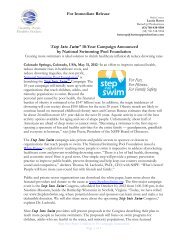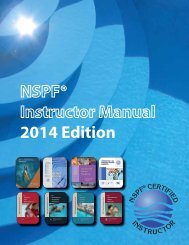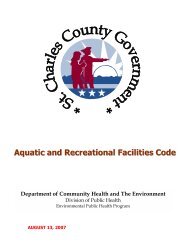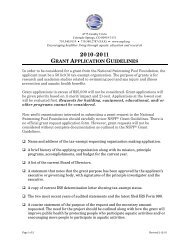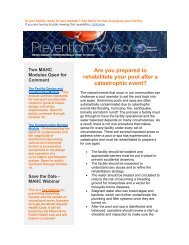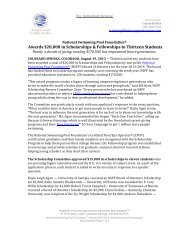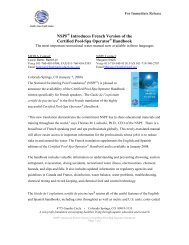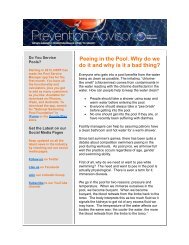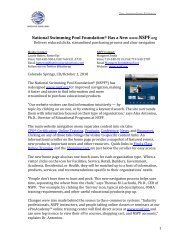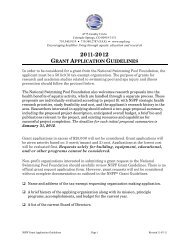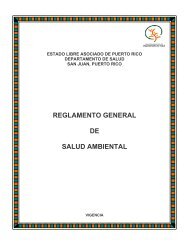English Instructor Manual (PDF) - Metric Version - National ...
English Instructor Manual (PDF) - Metric Version - National ...
English Instructor Manual (PDF) - Metric Version - National ...
Create successful ePaper yourself
Turn your PDF publications into a flip-book with our unique Google optimized e-Paper software.
Key Points: Discuss the various aspects of surge/balancing tanks. These include:<br />
Surge/balancing tanks function to accommodate overfl ow water in a system that uses<br />
overfl ow gutters. Since the water levels in these pools comes completely to the top,<br />
when water is displaced, it has no where to go. These tanks hold the overfl ow water<br />
until the system can allow it to return to the pool.<br />
Activity: Show the participants a coffee cup and saucer. Fill the cup with water up to the top<br />
without letting it overfl ow. Drop several marbles into the cup and observe the displacement of<br />
water over the sides of the cup and into the saucer. Now carefully remove the marbles from the<br />
water with a spoon or fork. Notice that the water level in the cup is lower than the original level.<br />
Now carefully take the saucer and pour the water back into the cup. The water should be back to<br />
its original level.<br />
The cup represents the pool. The saucer represents a surge or balancing take. In a pool, when<br />
water is displaced, it is stored in a tank, much like the water in the saucer. When the pool is once<br />
again inactive, mechanisms in the circulation system allow the pool water to return back to the<br />
original level, just like the coffee cup after the water had been replaced.<br />
Key Points: Discuss the various aspects of a hair and lint strainer. These include:<br />
Hair and lint strainers screen the pump from large debris that could damage the<br />
impeller.<br />
Hair and lint strainers should be checked regularly. Failing to check them regularly<br />
could prevent suffi cient water fl ow through the pump, causing reduced circulation,<br />
overheating, and damage.<br />
Key Points: Discuss the various aspects of a circulation pump and motor. These include:<br />
The pump and motor provide force that circulates water throughout the system. It is<br />
measured in litres per minute (lpm).<br />
The most important part of the pump is the impeller, which creates the suction and<br />
pressure to move the water. The impeller is to the circulation system what the heart is to<br />
the human body.<br />
The placement of the pump and motor in relation to the fi lters determines the type of<br />
circulation system the pool uses. If the pump is located before the filter(s), the system<br />
is a pressure system. If the pump is located after the fi lter(s), the system is a vacuum<br />
system.<br />
Key Points: Discuss the various aspects of meters and gauges. These include:<br />
Meters and gauges are designed to monitor system performance<br />
They are used to indicate suction (vacuum), pressure, water fl ow (fl ow meters),<br />
temperature, chemical levels, and water levels<br />
Key Points: Discuss the various aspects of valves. These include:<br />
Valves regulate the fl ow of water through the circulation system<br />
Types of valves include gate valves, ball valves, butterfl y, and multi-port valves<br />
© 2014 <strong>National</strong> Swimming Pool Foundation® Page 73



